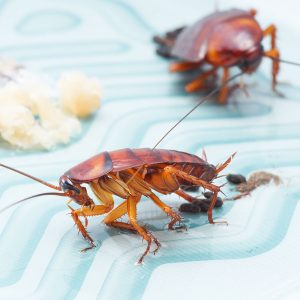Understanding Different Types of Cockroach Poison

There’s a common saying that cockroaches can survive a nuclear bomb. Even though this is a myth, it’s no wonder people believe it. And with all the different types of cockroach poison available, you’d think it would be near-impossible to get rid of a cockroach infestation.
But fear not, these pests that infest our kitchen sinks, food sources (including pet food), and kitchen cabinets can be killed. You just need to know which chemicals to use and what species of cockroach you’re dealing with. This is because different types hide in different areas in and around the home.
For treatment to be successful, roaches need to be targeted where they gather and hide, such as in crevices, cracks, and dark hard-to-reach places. And not out in the open. Ready to find out how to rid your home of its cockroach infestation? Read on!
Types of Insecticide Treatments
There are at least four different ways to treat roach infestations in your home: sprays, dusts, plastic baits, and gels.

Cockroach Spray
Cockroach spray comes in a spray bottle that releases a fine mist onto a desired area. As mentioned, the type of cockroach you’re dealing with will determine where you spray. If, for example, it’s the German cockroach, which likes kitchens and bathrooms with dark and damp areas in crevices and cracks, that’s where you’ll want to spray.
This species also likes areas like clocks and heat-producing electronics, such as toasters, but that doesn’t mean you should spray inside your toaster. Rather, spray near it in the corners where the wall meets the countertop. Like any type of chemical, cockroach spray can be effective if used the correct way. That said, products found in retail stores often aren’t effective at stopping a cockroach invasion long term, although you may see some short-term results.

Gels
With gels, keep in mind that cockroaches won’t be attracted to it from far away. It’s best to place the cockroach trap where it will be in the common pathways that these pests traverse. For example, along the edges of walls where they meet floors, or where wooden furniture connects (think of a built-in microwave stand—gel would go in the four corners inside).
You don’t need a lot of gel, just a pea-sized amount where you place it. That’s because you want the insects to walk over it. They’re not likely to do this if there’s a big glob of gel in their way. They may very well walk around, making your treatment ineffective.
Also keep in mind with gels, they’re not likely to kill the roach immediately. Usually it takes one-to-three days for it to work, which is a good thing. By that time, there’s a chance they’ve carried it back to the nest and infected others with it. But within a few weeks, you should see a marked difference in the number of cockroaches if you’ve done it right.
You might need to use quite a lot of gel. Don’t worry if you find yourself putting a dozen or more spots of gel around your kitchen, bathroom and wherever else you’ve seen signs of roaches. Again, it’s important to note that this method often won’t stop an infestation on its own. This is why calling in professional pest controllers is often necessary when you have a cockroach problem.
Plastic Baits
These are pre-prepared roach bait traps that you place flush into corners, usually where the wall meets the floor or the countertop. Much like the gel, they stay in one place, and you wait for the cockroach to walk across them. It’s usually filled with an appetising but deadly food source that they carry back to their nests.
Because roaches often feed on or breathe in the faecal matter of others, there’s a good chance other insects will be poisoned too. Again, it’s important to know what species you’re dealing with. If it’s the American cockroach, think about putting your baits in crawl spaces, near toilets, and rubbish bins.
They like dark, moist areas, as well as to be around sewerage systems and feed off trash. However, they do tend to travel far from their aggregation sites, so finding those is the key to getting rid of them completely. In each case, it’s probably best to call in professional pest control—people who know where to look for these nests and how to spot the signs of them.

Dusts
Some people find success with dusts or powders that are placed on the floor, usually containing boric acid or diatomaceous earth. The roaches walk through this powder, which then sticks to their feet and whatever other parts they come into contact with. The pests then lick these themselves to get the particles off and ingest the poison.
If you’re applying this dust, try using an applicator made for such a purpose, as the pests are unlikely to walk through a thick sprinkling—they’ll simply skirt it, making it ineffective. So, in this case, less is more, and the coating should be barely visible to the naked eye.
How to Get Rid of Cockroach Activity Safely
Remember, even retail insecticides can be dangerous for adults, children, and pets. Improper use can do more damage to your family than to the pests you’re trying to get rid of. We always recommend calling in a pest control company to treat insect infestations in your home.
The goal is dead roaches and a healthy, thriving family. Since cockroach control can get complicated and these beasts are notoriously hardy, calling in expert help is your best bet. You can get a free quote for cockroach control from one of our expert teams in your area today!
